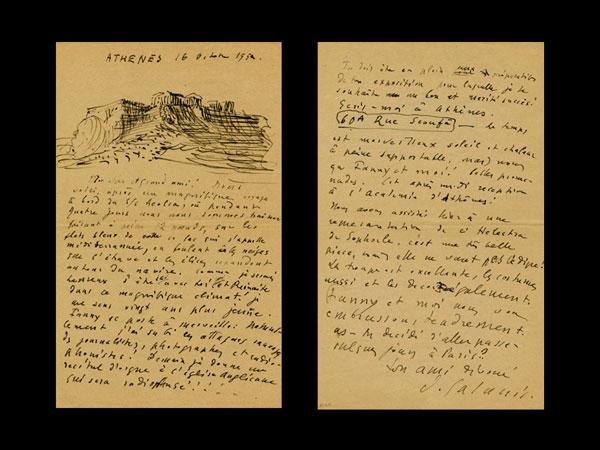Biography
Vassilis Photiades was born in Athens in 1902. From the seventeenth century his family had resided in the Fanar district of Constantinople, which is seat of the Ecumenical Patriarchate. However, its origins can be traced back to the island of Rhodes. Many members of the family were diplomats, holding high office in the administration of the Ottoman Empire. Others were men of letters. Brother of Vassilis Photiades’s great grandfather was Markos Mousouros, translator of Plato and friend of the publisher Aldo Manuzio [Aldus Manutius]. Photis Photiades, his father’s uncle, translated Dante’s Divine Comedy into ancient Greek. His grandfather, Ioannes Photiades, served as ambassador of the Sublime Porte, in Athens, St Petersburg, Florence (when it was capital of Italy for a brief interval) and Rome. As Governor General of Crete in the first years of the Pact of Halepa, he showed prudence, tolerance and flexibility. The Cretans publicly acknowledged the services of the fellow Christian Governor to their homeland during those difficult times.
From the age of fourteen, Vassilis Photiades studied for three years with the landscape painter Odysseas Phokas. This ‘apprenticeship’ proved decisive for his subsequent career as an artist. In 1919 he left Athens for good and began visiting and residing for long periods in Florence, Venice and Paris, where he studied also the exhibits in the museums. In 1924 he settled in the French capital, striking up friendships with Henri Matisse (1869 – 1954), Jean-Eduard Vuillard (1868 – 1940), Raoul Dufy (1872 – 1953) and André Derain (1880 – 1954).
In 1926 he trained in the studio of Dimitris Galanis, where he was involved in particular with the technique of wood engraving. In 1927 he participated in the exhibition of “Independent French Painters and Printmakers”, organized by the George Gallery in London. His first solo exhibition, in April 1929 in the Paul Durand-Ruel Gallery, received very favourable reviews. In the following years he exhibited regularly in the Salon d’ Automne and the Salon des Indépendants. In 1931 his decorative composition “The Annunciation to the Virgin” was exhibited in Athens and was greatly praised by Zacharias Papantoniou, Director of the National Gallery and eminent art critic.
1936 saw his triumphal entry into the domain of French literature, with his novel Marylene ou à qui le dire, which was extolled unanimously by Parisian critics. That same year his mother’s failing health obliged him to move to Lausanne. In 1940 he painted a series of portraits of Irène Aviolat, whom he later married. In the autumn of that year he exhibited forty oil paintings in the Gallerie Vallotton of Lausanne. In 1957 the Musée Cantonal des Beaux-Arts acquired his painting “Vue du Phalère”, and in 1958 the Stock publishing house circulated his collection of short stories entitled Les Transparents. In 1964 he contributed to the collective volume Histoire de la Peinture au XVIIIe siècle produced by the Dutch publisher Meulenhoff.
Vassilis Photiades died in 1975.
The Archive
In 2009 KIKPE acquired the greater part of the personal archive and the artistic oeuvre of the Greek diaspora painter and author Vassilis Photiades. The material that makes up the multifarious ‘Vassilis Photiades Collection’ falls into the following four categories: artistic work, correspondence, literary work and the photographic archive, with the artistic material constituting the major part of the archive. This particular section includes approximately 700 oil paintings, and 2.350 watercolours, drawings and prints. Most of these works were created in Europe during the period 1925-1965.
Particularly interesting is the unit with the correspondence between Photiades and leading personalities of the time, artists as well as distinguished figures in politics and society. These include André Gide, François Mauriac, André Malraux, Paul Valery, T.S Elliot, Jean Cocteau, George Seferis, Yannis Pappas, Robert Gallimard, Bernard Grasset and André Bay. In this unit, the correspondence between Photiades and Dimitris Galanis, comprising 90 illustrated letters spanning the period 1940-1963, holds pride of place.
Vassilis Photiades’s correspondence is complemented by the photographic and audio-visual archive with personal photographs, as well as photographs, negatives and transparencies relating to his diverse social and professional relations.
Special mention should be made here of Photiades’s literary oeuvre (prose and poetry). Indeed, some of his publications were designed by him personally and illustrated by Galanis. Significant too are the articles Photiades contributed to art and more general publications. Fascinating are the notebooks with his personal entries, embellished with sketches in his own hand.
The Vassilis Photiades Archive is currently undergoing an extensive cataloguing and management process as well as digitization of all its recordings. Through these activities, KIKPE aspires to provide public access to the collection through exhibitions and publications as well as virtually as content on the Foundation’s webs

































